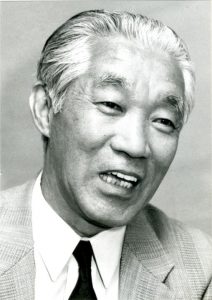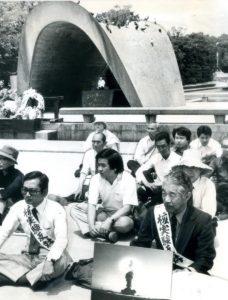My guidepost, Hiroshima pioneers: Shoji Kihara, 75, representative of citizens group, speaks about Yasuo Miyazaki
Sep. 2, 2024
Putting into practice idea of “even if not an A-bomb survivor”
by Hiromi Morita, Staff Writer
Shoji Kihara wears many hats in the anti-nuclear peace movement, including as representative of the No Nukes Hiroshima citizens group. This summer, marked by persistently intense heat, he worked up a sweat every day serving as a guide for groups and school students visiting Hiroshima’s Peace Memorial Park, located in the city’s Naka Ward, and surrounding areas.
“Without Mr. Miyazaki, I wouldn’t be involved in this work,” said Mr. Kihara as he recalled the pioneer who provided the impetus for his activities. Yasuo Miyazaki, who died in 2007 at the age of 78, served as secretary-general and representative of the Hiroshima Chapter of the Japan Congress against A-and H-Bombs (Gensuikin) and worked to support a variety of movements in the A-bombed city both publicly and from behind the scenes.
Mr. Miyazaki, a resident of Hikari City in Yamaguchi Prefecture during the war, did not experience the atomic bombing directly. However, through his involvement in the labor movement, he came to learn of the suffering of individual A-bomb survivors, or 'hibakusha.’ Moved by their anguished pleas, he turned a critical eye toward the world’s nuclear situation, continued to hold sit-ins to protest nuclear testing, and devoted himself to aid and relief campaigns by, for example, leading an “A-bomb survivor train” project to convey the stories and concerns of A-bomb survivors to the central government.
“Even if you’re not an A-bomb survivor, you can draw close by taking on the issue of the atomic bombing as your own cause,” Mr. Miyazaki would say. His attitude of speaking and putting into practice this catchphrase had an impact on younger people born after the war. Mr. Kihara said, “In the world of movements often marked by people looking down on others, Mr. Miyazaki quietly served as a role model.”
Mr. Kihara met Mr. Miyazaki when he was in his 20’s, a time in which he had started work at Nippon Telegraph & Telephone Public Corporation (present-day NTT) and was participating in a liaison council of second-generation A-bomb survivors in the All NTT Workers Union of Japan. He was approached by Mr. Miyazaki, a senior member of the union who was serving as secretary-general of the Hiroshima Prefectural Chapter of the Japan Congress Against A- and H-bombs. “There is an event that would be perfect for you,” Mr. Miyazaki had said. “Why don’t you join us?"
In May 1978, prior to the Special Session of the United Nations General Assembly devoted to Disarmament, held in New York, a joint Japan-U.S. anti-nuclear protest tour was planned. Mr. Kihara joined the tour as a second-generation survivor whose parents had experienced the atomic bombing.
Mr. Kihara spent 20 days visiting the Rocky Flats Plant (nuclear weapons manufacturing plant) in Colorado; Barnwell in South Carolina, where construction of a reprocessing plant was being planned at the time; a nuclear test site in Nevada; a Native American reservation on which was located a uranium mine; as well as other places, participating in demonstrations and gatherings. “Nuclear power generation and nuclear weapons are two sides of the same coin. I once again realized that nuclear power should not be used for peaceful or military purposes.”
Mr. Kihara also witnessed the grassroots, anti-nuclear spirit in the United States, itself a nuclear superpower. He said that on every August 6 and August 9, the days on which the atomic bombs were dropped on Japan, protests were held in front of nuclear power plants. Unlike Japan’s male-dominated movements, which relied on the mobilization of political parties and labor unions, such non-violent actions in the United States actively included women.
Mr. Kihara returned to Japan with a strong determination “to establish a similar anti-nuclear movement in the A-bombed city.” When he discussed the idea with Mr. Miyazaki, Mr. Kihara received his enthusiastic support. In October, a citizens group was formed. The launch ceremony attended by Mr. Miyazaki got off to a spirited start, with a band performance to express the group’s anti-nuclear sentiment. Mr. Kihara said, “We were pioneers in that time when many people thought the ‘peaceful use’ of nuclear energy was safe.”
The following year, an accident occurred at the Three Mile Island nuclear power plant in the United States, and in 1982, a move to attract a nuclear power plant to the town of Kaminoseki in Yamaguchi Prefecture came to light. In 1986, the Chernobyl nuclear power plant accident happened in the former Soviet Union. The anti-nuclear appeal became more relevant.
On a variety of occasions after that, Mr. Kihara would visit to talk with Mr. Miyazaki, who lived nearby. They also participated in sit-ins together, with Mr. Kihara always observing Mr. Miyazaki’s actions.
Even as he aged, Mr. Miyazaki was energetically involved in activities that transcended the boundaries of organizations and groups. He worked hard to locate witnesses necessary for Atomic Bomb Survivor’s Certificate applications and to support class-action lawsuits for the recognition of diseases caused by the atomic bombing. He was also busily involved in aid and relief activities for A-bomb survivors living overseas, including Chinese survivors. Furthermore, he supported a grassroots program to invite young people from India and Pakistan, two nuclear-armed nations in confrontation with each other, to the A-bombed city to engage in communication.
Mr. Kihara feels his own activities are “connected to Mr. Miyazaki who, based on the suffering of A-bomb survivors, opposed nuclear anything and aimed to create citizen-led movements.” Reflecting on Mr. Miyazaki’s words “even if you’re not an A-bomb survivor,” Mr. Kihara continues his work today.
Shoji Kihara
Born in 1949 in Hiroshima Prefecture’s town of Itsukaichi-cho (in Hiroshima’s present-day Saeki Ward), Mr. Kihara started work at Nippon Telegraph & Telephone Public Corporation (present-day NTT) in 1967 and retired in 2014. He serves in various posts, including as representative of the No Nukes Hiroshima citizens group, executive director of the Hiroshima Branch of Japan Congress against A-and H-Bombs (Gensuikin), editor and managing member of an anti-nuclear-power newspaper, guide for a group with the Hiroshima Prefectural Confederation of A-bomb Sufferers Organizations (chaired by Toshiyuki Mimaki) that works to explain Peace Memorial Park monuments, and assistant secretary-general of the Hiroshima City Association of Atomic Bomb Sufferers. He is a resident of Hiroshima’s Saeki Ward.
Keywords
A-bomb survivors train
A campaign in February 1975 in which A-bomb survivors and second-generation survivors of a Hiroshima Prefectural group, made up of 18 organizations of the General Council of Trade Unions of Japan, traveling to meet with government leaders in Tokyo on a special night train (group led by Yasuo Miyazaki) made their voices heard and demanded that the central government enact the Atomic Bomb Survivors Relief Law. The train left Hiroshima Station on February 25 with around 500 participants on board, and arrived in Tokyo the following day, February 26. The group engaged in diverse activities, including demonstrations around Japan’s Diet building and sit-ins near the Prime Minister’s official residence, calling for recognition of the situation facing A-bomb survivors.
(Originally published in September 2, 2024)










